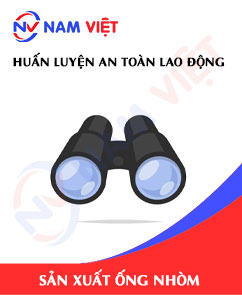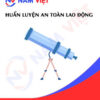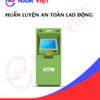Occupational Safety Training for Binocular Manufacturing
99,000 ₫
Note: The above price is calculated for one person, and the price may fluctuate depending on the number of learners participating in the course and market movements. For more accurate pricing support, please refer to the price list or contact our consulting staff directly.
Occupational safety is an important issue in binocular manufacturing factories and needs to be addressed promptly to ensure the health and safety of workers and enhance the reputation of enterprises. The Occupational Safety Training course is one of the effective solutions to raise awareness on how to prevent workplace accidents for workers participating in binocular manufacturing.
Table of Contents
Toggle1. Overview of binoculars
a. What are binoculars?
Binoculars are an optical device used to expand long-distance observation capabilities. They consist of two lenses with different diameters arranged in parallel, allowing users to see farther than with the naked eye.
The basic structure of binoculars includes a long focal length lens and a short focal length lens. The long focal length lens (objective lens) is placed far from the object being observed, functioning to focus light from the object and create an image at the real image point. The short focal length lens (ocular lens) is placed close to the user’s eye, magnifying the image created by the objective lens.
When looking through binoculars, users can see a magnified and clearer image compared to the naked eye. Binoculars are widely used in observation activities such as bird watching, hunting, traveling, nature exploration, astronomical research, as well as in military and medical applications.

b. Types of machines for binoculars manufacturing
The binoculars manufacturing process involves many types of machines and equipment. Below are some machines commonly used in the binoculars manufacturing process:
- Lens processing machine: This machine is used to process and manufacture lenses, including long focal length lenses and short focal length lenses. The lens processing machine handles grinding, polishing, and manufacturing the optical components of binoculars.
- Quality inspection machine: To ensure the quality of binoculars, quality inspection machines are used to check optical accuracy, magnification, sharpness, and other technical parameters of binoculars.
- Pressing and component assembly machines: During binocular assembly, machines are used to press and attach components, including lenses, prism systems, binocular frames, and other parts.
- Grinding and polishing machines: The surfaces of binoculars may be processed with grinding and polishing machines to make them smooth and achieve the required precision.
- Painting and finishing machines: After binoculars are assembled, painting and finishing machines are used to create the final exterior of the product, including coloring, metal plating, and other surface finishing.
In addition, the binoculars manufacturing process also involves other technologies and equipment such as milling machines, lathes, CNC grinding machines, and quality control systems to ensure the final product meets technical and quality requirements.

c. Binoculars manufacturing enterprises in Vietnam
Below are some binoculars manufacturing enterprises in Vietnam:
- Vinatronic JSC: Vinatronic is one of the leading enterprises in manufacturing and exporting binoculars in Vietnam. This company supplies high-quality binoculars for both domestic and international markets.
- Trung Hi-Tech Optics JSC: Trung Hi-Tech Optics (THO) is a company specializing in manufacturing binoculars and other optical devices. This company has many years of experience and provides high-quality products to various markets.
- Bach Tung Diep Co., Ltd: Bach Tung Diep is a binoculars manufacturing enterprise based in Ha Noi. This company specializes in manufacturing and supplying binoculars with various models and magnifications.
- Hoa Nguyen Optics Co., Ltd: Hoa Nguyen Optics is a binoculars manufacturing company located in Ho Chi Minh City. This company manufactures and supplies high-quality binocular products with various applications.
- VietScope Optics Co., Ltd: VietScope Optics is an enterprise specializing in manufacturing and trading optical products, including binoculars. This company is based in Ho Chi Minh City and provides diverse binoculars for multiple purposes.
Note that this list only provides some examples and does not represent all binoculars manufacturing enterprises in Vietnam. There may be many other companies in this industry, and the information may change over time.

d. Specific jobs in binoculars manufacturing factories
Group 1
- Chief executive officer, deputy chief executive officer, department heads in binoculars manufacturing factories.
Group 2
- Safety officers: managing safety in the factory, designing safety procedures, supervising and urging employees to comply with safe working procedures.
Group 3
- Lens manufacturing: This job includes processing and manufacturing lenses, including long focal length and short focal length lenses. The process includes grinding, polishing, assembling, and quality inspection of the lenses.
- Binocular assembly: This step includes assembling the optical and mechanical components of binoculars. It is an important stage to ensure components operate accurately and fit together.
- Quality inspection: Binocular parts after assembly will be inspected to ensure optical accuracy, magnification, and other technical specifications meet requirements.
- Component attachment: After quality inspection, components such as lenses, prism systems, and binocular frames will be attached together with suitable machines and tools.
- Product finishing: The final exterior of binoculars will be completed, including painting, metal plating, and other surface treatments to create a high-quality, aesthetic product.
- Packing and transportation: After the product is completed, it will be packaged and boxed for protection and transport to the final destination, including retailers or end customers.
Group 4
- Office work, service, sales, marketing.
- Production management, quality management, human resources management, materials management, financial and accounting management.
- Design and development: Engineers and designers will take on the task of designing and developing binocular models based on customer requirements and market research.
2. Overview of occupational safety training for binoculars manufacturing
Within the scope of this article, we focus on issues related to group 3, because group 3 directly participates in the manufacturing process and faces the highest occupational safety risks. Refer to other groups here
a. What is occupational safety training for group 3?
- Occupational safety training group 3 are sessions that provide awareness of how to prevent occupational accidents for workers.
- The occupational safety training course will help workers recognize and avoid hazards, reducing the risks of occupational accidents during work.
REGISTER FOR OCCUPATIONAL SAFETY TRAINING SERVICE
b. Training duration
First-time occupational safety training duration
- Total training duration is at least 24 hours, including examination time.
- 8 hours of theoretical study on occupational safety and hygiene policies and laws
- 8 hours of theoretical study on basic knowledge of occupational safety and hygiene
- 4 hours of theoretical study on specialized training content
- 2 hours of practical training on specialized training content
- 2 hours of theoretical examination at the end of the training course
The occupational safety training center will arrange the schedule into several training sessions depending on the arrangement of time for workers. Typically, there will be 6 training sessions, the course will last 3 days, provided that the manufacturing enterprise arranges continuous study time.
Periodic occupational safety training duration
- Before the occupational safety card expires, workers who want renewal must undergo periodic occupational safety training, with training duration being at least 50% of the initial training duration.
Explanation: the total duration of periodic occupational safety training is at least 12 hours, including examination time. After completing periodic training and passing the required test, workers will be reissued or extended occupational safety cards.
c. Content of the training course
| No. | TRAINING CONTENT | TRAINING DURATION (HOURS) | |||
| Total | Including | ||||
| Theory | Practice | Examination | |||
| I | System of occupational safety and hygiene policies and laws | 8 | 8 | 0 | 0 |
| 1 | Overview of the system of legal normative documents on occupational safety and hygiene. | 6 | 6 | ||
| 2 | System of occupational safety and hygiene standards and technical regulations. | 1 | 1 | ||
| 3 | Specific regulations of state management agencies on occupational safety and hygiene when building new, expanding, or renovating facilities to manufacture, use, store, and inspect machinery, equipment, materials, and substances with strict requirements on occupational safety and hygiene. | 1 | 1 | ||
| II | Basic knowledge of occupational safety and hygiene | 8 | 8 | 0 | 0 |
| 1 | Basic knowledge of hazardous and harmful factors in the workplace. | 4 | 4 | ||
| 2 | Methods of improving working conditions. | 1 | 1 | ||
| 3 | Safety culture in manufacturing and business. | 1 | 1 | ||
| 4 | Rights and obligations of employers and employees; occupational safety and hygiene policies and regimes for employees; functions and tasks of the occupational safety and hygiene network. | 1 | 1 | ||
| 5 | Occupational safety and hygiene regulations, signs, instructions, and use of safety equipment, personal protective equipment; professional skills for first aid in occupational accidents, and prevention of occupational diseases. | 1 | 1 | ||
| III | Specialized training content | 6 | 4 | 2 | 0 |
| General knowledge of types of machinery, equipment, and substances generating hazardous and harmful factors; analysis, assessment, and risk management in occupational safety and hygiene; safe working procedures with machinery, equipment, and substances with strict requirements on occupational safety and hygiene. | 6 | 4 | 2 | ||
| IV | Examination on occupational safety training content at the end of the course | 2 | 2 | 0 | 0 |
| Total | 24 | 22 | 2 | ||
See more training content of 6 groups
d. Occupational safety card
After completing occupational safety training and passing the examination, workers will be issued an occupational safety card (commonly known as a occupational safety certificate for group 3).
The group 3 safety card will clearly show information such as full name, date of birth, job, and specific working environment. It also includes training duration, a red seal, and a signature confirming course completion.
According to the regulations on safety card issuance stated in clause 2 Article 24 Decree 44/2016/ND-CP, there are two cases:
- In the case where the employer and employee have a labor contract, the employer must sign, stamp, and seal the safety card for the trained worker in group 3 after completing the training course from the occupational safety training unit and passing the examination.
- In the case of freelance or seasonal workers without a labor contract, the training unit must sign, stamp, and seal the safety card for the worker after completing the training course from the occupational safety training unit and passing the examination.

3. Identifying hazards affecting workers in binocular manufacturing
During the binocular manufacturing process, there are potential hazards that may affect the health and safety of workers. Below are some main hazards that need to be identified:
- Hazards from chemical materials: During processing and finishing, chemical substances such as solvents, detergents, adhesives, dyes, and paints can be harmful to health if not used and handled properly. Workers may come into direct contact or inhale vapors, dust, and liquids that are hazardous.
- Hazards from dust and fine particles: The processes of grinding, polishing, and machining metals and other materials can generate dust and fine particles. Inhaling dust and particles can harm the respiratory system and cause health issues such as pneumonia, obstructive pulmonary disease, and allergies.
- Hazards from electricity: If electrical equipment in the factory is not regularly maintained, not properly insulated, or not waterproof, it will pose the risk of electric shock to workers during the manufacturing process.
- Hazards from light and ultraviolet rays: During binocular manufacturing and inspection, strong light and ultraviolet rays may be used. Prolonged exposure to strong light and ultraviolet rays can cause burns, skin damage, and vision problems.
- Hazards from tools and machinery: During processing and assembly, the use of machinery and tools such as grinders, milling machines, cutting machines, and electrical equipment may cause workplace accidents. Workers must follow safety rules when using and operating these devices to avoid injuries and accidents.
- Hazards from physical impacts: The processes of machining and assembling binoculars may create physical impacts such as vibration, noise, and air pressure. Long-term exposure to these factors can harm the nervous system, hearing, and overall health.

4. Common occupational accidents in binocular manufacturing
During binocular manufacturing, there are some common occupational accidents that can cause injuries to workers. Below are some common types of workplace accidents in binocular manufacturing:
- Cutting and puncture accidents: When working with sharp machines and tools, workers may suffer cuts or puncture injuries if safety rules are not followed or equipment is used improperly.
- Impact and collision accidents: While moving materials, components, or heavy tools, workers may collide with heavy objects or be crushed by them, leading to injuries or fractures.
- Falling and slipping accidents: Factory floors may be slippery due to oil or waste, causing risks of falls or slips. This can result in bone injuries, broken arms, legs, or head trauma.
- Accidents from physical forces: During the use of machines and equipment, workers may face accidents caused by physical forces such as impact, explosions, flying debris, or heavy objects falling and causing injuries.
- Accidents from exposure to toxic substances: Some toxic chemicals may be used in binocular manufacturing. If safety measures are not followed, workers may be exposed to toxic substances through inhalation, skin contact, or ingestion, leading to injuries or health problems.
- Accidents from electrical equipment: Using electrical equipment during the manufacturing process can cause the risk of electric shock or fire and explosion if safety rules are not followed and equipment is not used properly.
5. Safety measures in binocular manufacturing
When participating in binocular manufacturing, workers need to comply with safety measures to protect their health and ensure safe working conditions. Below are some important safety measures:
- Be trained and understand occupational safety: Workers must be trained on safety rules, working procedures, and occupational safety knowledge. They should understand and comply with specific safety regulations and rules related to binocular manufacturing.
- Use personal protective equipment: Ensure the use of personal protective equipment (PPE) such as safety glasses, gloves, helmets, masks, ear protection, protective clothing, anti-slip shoes, and other PPE suitable for the tasks being performed.
- Proper handling of chemicals: Ensure safe use, storage, handling, and transportation of chemicals. Follow instructions for use and personal protection when handling toxic substances.
- Follow rules for operating machinery and equipment: Operate machines and equipment according to safety rules, comply with user instructions, and conduct regular inspections and maintenance to ensure safe and efficient operation.
- Control physical risks: Ensure safety when moving, installing, and using materials, components, and tools. Provide preventive measures against collisions, crushing, slipping, and other physical impacts.
- Control risks from exposure to light and toxins: Use personal protective equipment and control measures against exposure to strong light, ultraviolet rays, and toxic substances.
- Regularly organize work environment monitoring in factories and enterprises to collect and analyze harmful factors to workers, thereby adjusting and reducing risks to prevent occupational diseases.
6. Benefits of occupational safety training in binocular manufacturing
An Toan Nam Viet provides your business with outstanding benefits after completing occupational safety training courses in accordance with Decree 44/2016/ND-CP on occupational safety and hygiene for companies, factories, and enterprises.
- Workers can recognize potential risks of occupational accidents and take preventive measures to avoid accidents.
- Businesses can establish preventive measures against risks in manufacturing, operation, and maintenance processes.
- Minimize costs when occupational safety risks occur.
- Uninterrupted manufacturing processes help increase productivity and product quality.
- Ensure compliance with occupational safety laws and avoid legal risks.
- Create credibility and professionalism in all aspects, thereby enhancing the brand value of the business.
The training courses of Nam Viet are preventive solutions against external factors affecting each individual, helping them avoid dangers that may lead to injury or, more seriously, death.
REGISTER FOR OCCUPATIONAL SAFETY TRAINING SERVICE
7. Customer feedback after completing occupational safety training in binocular manufacturing
An Toan Nam Viet has many years of experience in the mission of accompanying many businesses in Vietnam in general and in the southern provinces in particular. That responsibility for Nam Viet is extremely valuable, which is why the occupational safety training of Nam Viet is always increasingly professional. The driving force for An Toan Nam Viet to grow strongly to this day comes from the positive feedback and contributions from businesses. Below are the responses from our partners that we have served.
Bac Nam E&C Construction Investment Joint Stock Company
“The first time I used the service at An Toan Nam Viet, I was very surprised by the enthusiastic 24/7 support of the consulting team. The organization of the class was very quick and convenient for our company, thank you very much for Nam Viet’s service!”
Hoa Dat Construction and Trading Joint Stock Company
“Nam Viet’s service has helped us a lot in simplifying occupational safety and completing safety documentation for our working process. The consulting team was enthusiastic and timely in addressing our questions. 5 stars for Nam Viet.”
See more customer interviews after using the service of An Toan Nam Viet
8. Occupational Safety Training Capability of An Toan Nam Viet
An Toan Nam Viet is a prestigious and high-quality occupational safety training center in Vietnam today. With occupational safety training sessions continuously held at manufacturing workshops, factories, or construction sites across the country (63 provinces in Vietnam).
REGISTER FOR OCCUPATIONAL SAFETY TRAINING SERVICE
License for occupational safety training
- An Toan Nam Viet has been inspected and certified by the Occupational Safety Department of the Ministry of Labor – Invalids and Social Affairs and granted a certificate of eligibility to operate in occupational safety and hygiene training. This further strengthens our capacity in occupational safety training.

Training materials and lectures
- Before occupational safety training materials are used in training courses, they are reviewed and approved to ensure the lectures are accurate in knowledge and effective when applied.
- The teaching methods of the instructors are standardized according to the teaching standards of An Toan Nam Viet, methods that occupational safety and hygiene training experts have researched and developed during teaching to maximize learners’ knowledge acquisition.
Facilities
- Controlling classroom factors that affect the training process will increase teaching efficiency and learners’ knowledge absorption.
- Training support facilities are always arranged in spacious classrooms meeting standards for area, lighting, and training equipment, etc.
9. Prestigious and high-quality nationwide occupational safety training center
At An Toan Nam Viet, we always prioritize our professional mission of occupational safety training. For us, imparting knowledge for workers to protect themselves so they have safety skills on their career journey is contributing to nation-building.
To ensure effective training, we carefully and meticulously prepare even the smallest details. From preparing tools, teaching equipment, curricula, documents, sound, and lighting.
Our occupational safety training instructors are experts with many years of experience in the field. They even have research projects on identifying hazards in all industries and methods of prevention.
The lectures are drawn from practice and delivered in a lively and understandable way to workers. These elements help workers feel comfortable during learning and effectively absorb the knowledge we teach. Of course, the knowledge delivered is always aligned with Decree 44/2016/ND-CP.
From there, workers grasp many preventive measures against hazards and ways to protect themselves. At the same time, they can apply them appropriately in their actual work.
Our occupational safety training center is proud to be a reputable, professional occupational safety training provider with the following advantages:
- Competitive training costs while maintaining quality.
- Flexible training schedules aligned with the company’s production conditions.
- Fast and legally compliant certification procedures.
- Instructors with many years of professional experience.
- Classrooms controlled for factors affecting training efficiency and knowledge absorption.
- Lectures tailored to the occupational safety requirements of enterprises.
- An Toan Nam Viet works with dedication and professionalism to support customers accurately and quickly.

10. Additional reference materials for occupational safety training in binocular manufacturing
- Occupational safety materials for binocular manufacturing
- Occupational safety training material set
- Occupational safety training test set
- Occupational safety training curriculum for binocular manufacturing
- Occupational safety multiple-choice test for binocular manufacturing
1 review for Occupational Safety Training for Binocular Manufacturing
No comments yet















namchinh.haiphong341
Dịch vụ tốt!!!